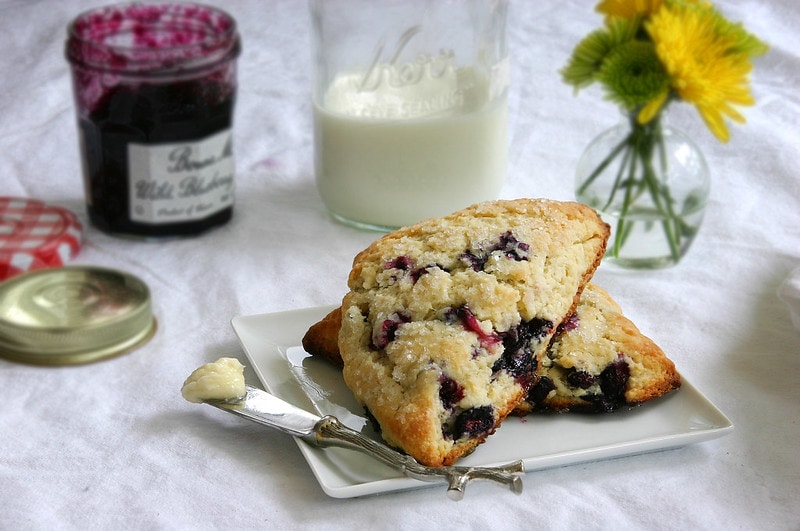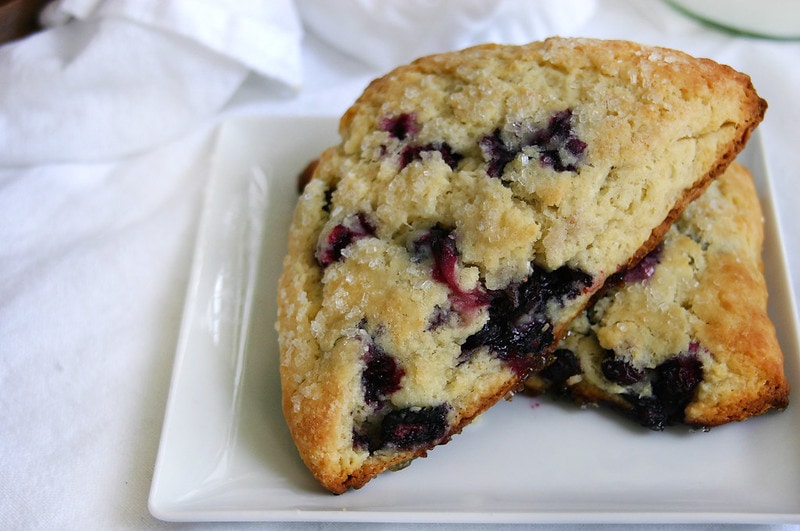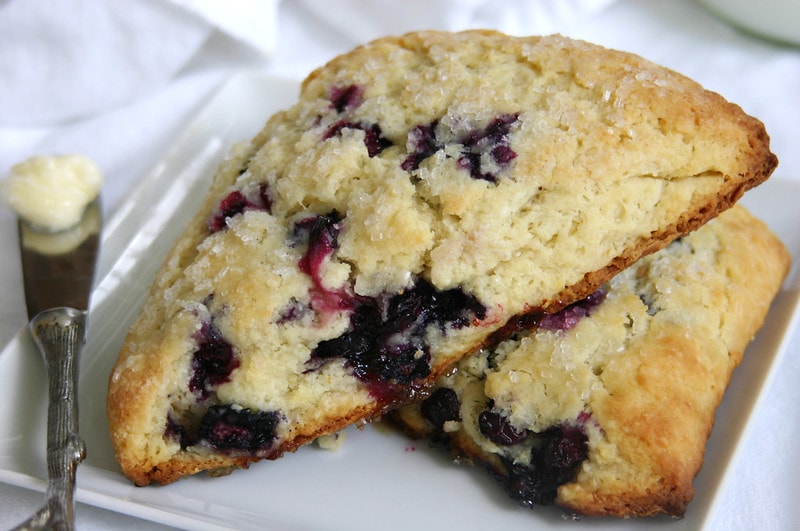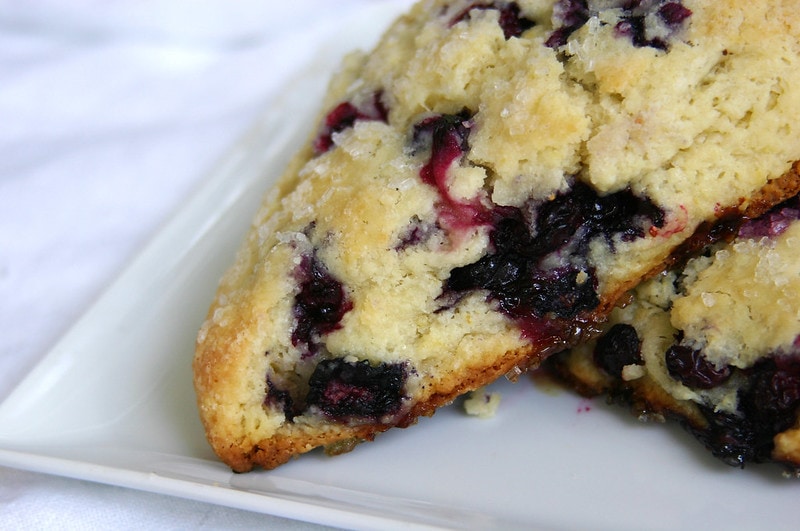
Not being a Briton, I don’t believe I can weigh in on what constitutes a “proper” scone, but I do know that the ubiquitous dry lumps languishing in coffeeshop display cases do not tempt me. Except for one, a long time ago.
None of our pastries were made in house but were delivered to us each morning by a man that ran a small baking company out of his home. The delivery consisted of pastry case staples: croissants, pain au chocolate, cookies, bagels, and these large, triangular cranberry scones with a sparkling sugar crust on top. I don’t think I’d eaten a scone before trying his, or if I had previously eaten one it was, evidently, entirely forgettable. Those scones were a tender epiphany that I then described as “like a hybrid between cookie and cake”. I left New Orleans after Katrina, and when I returned years later I made a special trip to Café Luna specifically for one of those scones only to be told the man that baked them, like so many people, was no longer in New Orleans. I felt defeated and quickly accepted that I would never have a scone like that again in my life. At the time I identified strictly as a savory cook, not a baker, so trying to recreate them didn’t occur to me as an option. Game over, man. Game over.
After having made them a few times now, I can happily say that I’ve found another scone to love. My understanding of the scone has evolved from “cookie cake” to a relative of the biscuit. Made with buttermilk, sour cream, butter, and a touch of heavy cream, these scones do not pretend to be healthy, and their fat content relative to the flour is so high they almost melt when baking. Almost. That said, they freeze beautifully so there is never any need to make a big batch of them unless you’re cooking for a crowd. I usually bake one or two which we eat while still warm and freeze the rest. Freezing them is also nice because scones do not age particularly well and benefit from being eaten within 12 hours of baking. That all said, I think these are the best scones you will ever have. Honestly. They’re a wonderful albeit indulgent breakfast and an excellent stage on which any number of fillings can shine, my favorite being fresh berries which results in the lyrical “jammy pockets” rhapsodized by Kate (of Cookie + Kate).

Ingredients
- 8 tbsp. 113 g / 1 stick unsalted butter, frozen whole
- 1½ cups 7½ oz. fresh blueberries (or blackberries for variation)
- ½ cup buttermilk
- ½ cup sour cream
- ¼ cup heavy cream
- 2 cups 250 g / 10 oz. all-purpose flour, plus more for dusting the work surface
- ½ cup 96 g sugar, plus 1 tbsp., plus extra for sprinkling
- 2 tsp. baking powder
- ¼ tsp. baking soda
- ½ tsp. salt
- 1 tsp. finely grated lemon zest plus 1 tsp. fresh thyme, chopped for variation
- 2 tbsp. unsalted butter melted
Instructions
- Adjust an oven rack to middle position and preheat to 425˚ F. Grate the frozen butter on the holes of a large box grater. (You can use a food processor if you prefer.)
- Whisk together the buttermilk, sour cream, and heavy cream in a medium bowl; refrigerate until needed. Combine the flour, ½ cup sugar, baking powder, baking soda, salt and lemon zest (and thyme if using) in a medium mixing bowl. Whisk to combine. Add the grated butter to the flour mixture and toss with fingers until thoroughly coated.
- Add the milk mixture to the dry ingredients and fold with a spatula just until combined. Transfer the dough to a generously floured work surface. Dust the top of the dough with flour and form the dough into a ragged ball, kneading lightly as needed. Add small amounts of flour as needed to prevent sticking.
- Blueberry Buttermilk Scones
- Roll the dough (I simply pat it out gently with my hands) into a 12-inch square. Fold the dough into thirds like a business letter carefully, making sure it isn’t sticking. Fold the short ends of the dough into the center in thirds, to form an approximate 4-inch square. At this point the dough can be transfer thto a plate lightly dusted with flour and chilled in the freezer for 5 minutes to make it easier to work with (I skip this step).
- Return the dough to the floured work surface and roll (or pat) into an approximately 12-inch square again. Sprinkle the blueberries (or blackberries) evenly over the surface of the dough, and gently press down so that they are slightly embedded in the dough surface. Sprinkle with 1 tbsp of sugar. Gently roll the dough up to form a tight log. Lay the log seam side down and carefully press the the log into a 12 by 4-inch rectangle. Using a sharp, floured knife or bench scraper, cut the rectangle crosswise into 4 equal rectangles. Cut each rectangle diagonally to form 2 triangles. Transfer to a parchment lined baking sheet.
- Brush the tops of the scones with melted butter and sprinkle with sugar. (If freezing ahead of time, flash freeze on the baking sheet for 20 minutes, then wrap individually and store in a freezer bag until needed. To bake from frozen bake directly from freezer for about 20-27 minutes. Do not thaw.) Bake until the tops and bottoms are golden brown, 18-25 minutes. Transfer to a wire rack and let cool 10 minutes before serving.
My name is Beth, Elizabeth Evelyn to be exact. A native Tennessean, I was born in the South.
I am the author behind Local Milk Blog.













